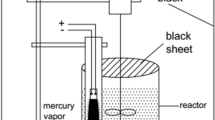Abstract
Combined technology of SDS-CuO/TiO2 photocatalysis and sequencing batch reactor (SBR) were applied to treating dyestuff wastewater. Photocatalysis was carried out in a spiral up-flow type reactor as pre-treatment. SDS-CuO/TiO2 photocatalyst was prepared by modification of nano-TiO2 using CuO and sodium dodecyl sulfate (SDS). Results show that the SDS-CuO/TiO2 photocatalyst contains two kinds of crystals, including TiO2 and CuO. The band gap of this photocatalyst is 1.56 eV, indicating that it can be excited by visible light (λ<794.87 nm). And characterization also shows that there are alkyl groups on its surface. It takes 40 min to improve the biodegradability of dyestuff wastewater. Five-day biochemical oxygen demand (BOD5) and dehydrogenase activity (DHA) of wastewater reach the maximum value when dissolved oxygen is higher than 2.97 mg/L. SBR reactor was used to treat this biodegradability improved wastewater. Chemical oxygen demand (COD) and colority decline to 72 mg/L and 20 times, respectively, when the sludge loading is 0.179 kg(COD)/[kg(MLSS)·d], dissolved oxygen is 4.09 mg/L and aeration time is 10 h.
Similar content being viewed by others
References
ROBINSON T, CHANDRAN B, NIGAM P. Removal of dyes from a synthetic textile dye effluent by biosorption oon apple pomace and wheat straw [J]. Water Research, 2002, 36: 1743–1748.
AHN D H, CHANG W S, YOON T I. Dyestuff wastewater treatment using chemical oxidation, physical adsorption and fixed bed biofilm process [J]. Process Biochemistry, 1999, 34: 429–439.
LIU Wei, CHEN Shi-fu, ZHAO Wei, ZHANG Su-juan. Titanium dioxide mediated photocatalytic degradation of methamidophos in aqueous phase [J]. Journal of Hazardous Materials, 2009, 164: 154–160.
CRISITINA A, ARTURO M A, SIXTO M, ANA B. New insights on solar photocatalytic degradation of phenol over Fe-TiO2 catalysts: Photo-complex mechanism of iron lixiviates [J]. Applied Catalysis B: Environmental, 2009, 93(1/2): 96–105.
KOHTANI S, INAOKA Y, HAYAKAWA K, NAKAGAKI R. Degradation of benzo[a]pyrene using TiO2 and Ag-loaded BiVO4 photocatalysts: Evaluation by the Ames mutagenicity assay [J]. Journal of Advanced Oxidation Technologies, 2007, 10(2): 381–386.
YAMASHITA H, HARADA M, MISAKA J, TAKEUCHI M, NEPPOLIAN B, ANPO M. Photocatalytic degradation of organic compounds diluted in water using visible light-responsive metal ion-implanted TiO2 catalysts: Fe ion-implanted TiO2 [J]. Catalysis Today, 2003, 84: 191–196.
HU Chun, WANG Yi-zhang. Decolorization and biodegradability of photocatalytic treated azo dyes and wool textile wastewater [J]. Chemosphere, 1999, 39(12): 2107–2215.
JONSTRUP M, WAERJERSTAM M, MURTO M, MATTIASSON B. Immobilisation of TiO2 for combined photocatalytic-biological azo dye degradation [J]. Water Science & Technology, 2010, 62(3): 525–531.
BOLDUC L, ANDERSON W A. Enhancement of the biodegradability of model wastewater containing recalcitrant or inhibitory chemical compounds by photocatalytic pre-oxidation [J]. Biodegradation, 1997, 8(4): 237–249.
TURCHI C S, OLLIS D F. Photocatalytic degradation of organic water contaminants: Mechanisms involving hydroxyl radical attack [J]. Journal of Catalysis, 1990, 122(1): 178–192.
XU Xuan, JI Fang-ying, FAN Zi-hong. Design of spiral up-flow tower-type photocatalysis reactor [J]. China Water & Wastewater, 2009, 25(23): 79–81. (in Chinese)
WANG Jian-fang, JIN Wen-biao, ZHAO Qing-liang, LIU Zhi-gang, LIN Ji-kan. Peformance of treating wastewater and anti-shockloading in oxic-settling-anaerobic (OSA) process for minimization of excess sludge [J]. Environmental Science, 2007, 28(11): 2488–2493. (in Chinese)
WU Ling, YU J C, FU Xian-zhi. Characterization and photocatalytic mechanism of nanosized CdS coupled TiO2 nanocrystals under visible light irradiation [J]. Journal of Molecular Catalysis A: Chemical 2006, 244(1/2): 25–32.
GOPIDAS K R, BOHORQUEZ M, KAMAT P V. Photophysical and photochemical aspects of coupled semiconductors: Charge-transfer processes in colloidal CdS-TiO2 and CdS-AgI systems [J]. J Phys Chem, 1990, 94(16): 6435–6440.
GHIJSEN J, TJENG L H, VANELP J, ESKES H, WESTERINK J, SAWATZKY G A, CZYZYK M T. Electronic structure of Cu2O and CuO [J]. Physical review B: Condensed Matter and Materials Physics, 1988, 38(16): 11322–11330.
KOFFYBERG F P, BENKO F A. A photoelectrochemical determination of the position of the conduction and valence band edges of p-type CuO [J]. Journal of Applied Physics, 1982, 53(2): 1173–1177.
ROBERT D. Photosensitization of TiO2 by MxPy and MxSy nanoparticles for heterogeneous photocatalysis applications [J]. Catalysis Today, 2007, 122(1/2): 20–26.
TIAN Guang-lei, HE Hong-bo, SHAO Jian-da. Effect of Microstructure of TiO2 thin films on optical band gap energy [J]. Chinese Physics Letters, 2005, 22(7): 1787–1789.
AL-ANI S K J, HIGAZY A A. Study of optical absorption edges in MgO-P2O5 glasses [J]. Journal of Materials Science, 1991, 26: 3670–3674.
WANG Zhi-yu, TANG Pei-song, JIANG Yu-long, FAN Xian-ping, QIAN Guo-dong, HONG Zhang-lian. Study on fluorescence and diffuse reflection spectrum of nanosized TiO2 [J]. Rare Metal Materials and Engineering, 2004, 33(Suppl.3): 162–168. (in Chinese)
FRIEDMAN L, FISHEL DL, SHECHTER H. Oxidation of alkylarenes with aqueous sodium dichromate: A useful method for preparing mono-and polyaromatic carboxylic acids [J]. The Journal of Organic Chemistry, 1965, 30(5): 1453–1457.
ZHANG Wen, WANG Xu-xu, LIN Hua-xiang, FU Xian-zhi. Influence of magnetic field on the formation rate of hydroxyl radical in photocatalysis [J]. Acta Chimica Sinica, 2005, 63(18): 1765–1768.
OH Y K, KIM Y J, AHN Y, SONG S K, PARK S. Color removal of real textile wastewater by sequential anaerobic and aerobic reactors [J]. Biotechnology and Bioprocess Engineering, 2004, 9(5): 419–422.
JIN Yi-zhong, WEI Yan-yan, CHEN Xiao-ping. Studies on treatment of printing and dying wastewater by hydrolysis and acidification-SBR technology [J]. China Environmental Science, 2004, 24(4): 489–491. (in Chinese)
Author information
Authors and Affiliations
Corresponding author
Additional information
Foundation item: Project(CDJZR11210009) supported by the Fundamental Research Funds for the Central Universities of China
Rights and permissions
About this article
Cite this article
Xu, X., Ji, Fy., Fan, Zh. et al. Dyestuff wastewater treatment by combined SDS-CuO/TiO2 photocatalysis and sequencing batch reactor. J. Cent. South Univ. Technol. 19, 1685–1692 (2012). https://doi.org/10.1007/s11771-012-1194-z
Received:
Accepted:
Published:
Issue Date:
DOI: https://doi.org/10.1007/s11771-012-1194-z




